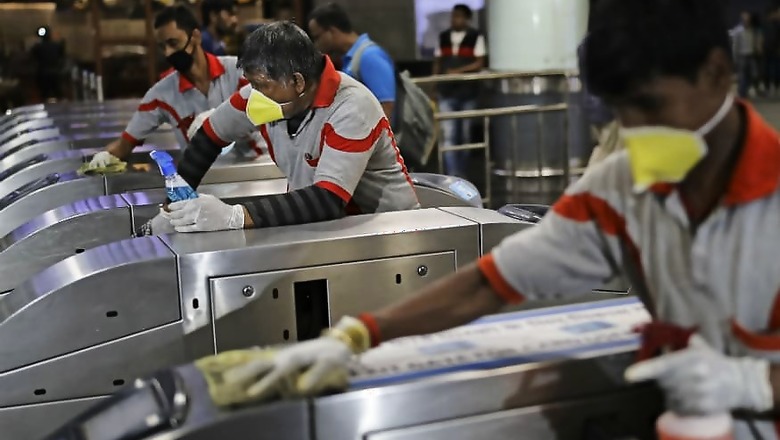
views
“A community transmission is inevitable but we are ready to deal with it,” Director General of the Indian Council for Medical Research, Professor Balram Bhargava, said last week, summing up the resolve of the government in taking coronavirus head on and also showing how the government knows the worst is yet to come.
India is at Stage 2 of COVID-19, which in medical parlance would be called local transmission. This means we have imported cases who are now transmitting the infection to their relatives and contacts. The third stage is community transmission, not seen in India yet and the fourth is that of an epidemic as in China and Italy where complete lockdowns have been ordered.
So, how well have we done in preparing ourselves for COVID-19? Fairly well, Quite well!
We have made a good start by screening passengers at airports. India kicked in this regime much earlier than many other counties. We started screening passengers from China on January 17, 17 days after China told the World Health Organisation about the presence of the mysterious Wuhan Pneumonia that was later called 2019 nCOV and then eventually rechristened COVID-19 (CoronaVirusDisease 2019).
Knowing well that China is reporting an increase in cases and that passengers from China were travelling out of the country, could India have started screening earlier? Maybe, yes.
But India moved fast after this realisation. Screening at airports went up; from seven to 13 to 21, India is now screening at 30 international airports.
Thermal screening, as is being carried out today at 30 airports, applies to all international passengers coming to India. Globally, 131 countries stand affected but, unfortunately, many patients of COVID-19 turned symptomatic after a few days of arriving in India. India tried hard to handle the problem by making self-declaration of symptoms (if any) mandatory at immigration but this again is an unscientific method to monitor symptoms. About 12 lakh passengers coming from abroad have been screened for coronavirus at various airports across the country until today. Logistically, this is a daunting task but India is doing it.
India has done very well with screening at seaports and land border crossings. India also went to the extent of using the help of village panchayats to educate people in rural areas, especially in states like Uttarakhand that shares borders with Nepal. Surveillance and screening is being carried out at 77 seaports in the country in cooperation with the Ministry of Shipping.
India also gets a 10 on 10 for timely sample testing and setting up of extra laboratories to test suspected cases. Under the Indian Council of Medical Research, India strengthened its network of laboratories to test samples of COVID-19 suspects. As many as 52 laboratories are now operational across the country to test for COVID-19. An additional 57 laboratories have been provided with viral transport media and swabs for sample collection.
According to the ICMR, the government labs are underutilised. Each lab has a testing capacity of 90 samples per day and ICMR says just about 50-60 samples are studied in each lab, much below its capacity. Earlier, the National Institute of Virology was the only lab carrying out the second test or the confirmation test that is required to declare a suspected case confirmed. Over 45 days, 31 labs have been set up to carry out the secondary tests, thus reducing the dependence on NIV Pune. A source at ICMR said NIV Pune has also tested samples from SAARC countries.
The first coronavirus case was confirmed in India on January 30. Since then, 6,500 samples of 5,900 individuals have been tested in the country, the Indian Council of Medical Research says.
As the question arises if India is testing enough, it depends on how we look at it. A section of India's medical fraternity says test more, like South Korea is doing, to gauge if there is community transmission already. Under the current testing protocols released by ICMR, only those with history of travel to high-risk countries affected by COVID-19 and those who came in contact with persons testing positive were asked to be quarantined for 14 days. Among them, only those who show symptoms of coronavirus infection are being tested. Testing too much also gives a false sense of assurance, says the ICMR.
However, viral research and diagnostic laboratories testing COVID-19 samples are also periodically testing samples of patients suspected to be having Influenza-like illness or those displaying severe pneumonia symptoms. Dr Nivedita Gupta, scientist, Epidemiology and Communicable Diseases Division, says this is an epidemiologically relevant method to pick up community transmission.
Lav Aggarwal, Joint Secretary, Union Health Ministry, says there are around 1 lakh coronavirus testing kits available in India, while additional testing kits have already been ordered and are in procurement. ICMR says testing laboratories have been supplied with the primers, probes, PCR reagents, positive and negative controls, and standard operating procedure (SOP) by the National Institute of Virology. Further, NIV is also undertaking quality control activities. It maintains an inventory of reagents for itself and testing labs. Currently, NIV has sufficient reagents for facilitating testing in the entire network. We appear to be well stocked!
Under the directions of the Prime Minister, the Government of India set up a task force, a Group of Ministers involving several ministries, to carry out surveillance, isolation, treatment and other measures to deal with the pandemic.
India also identified its strengths quickly — a large network of private hospitals were roped in by the government to build capacity for suspects and confirmed patients. A private hospital in Gurugram is treating 14 Italian nationals. The private network has been roped in for surveillance, isolation and treatment. Similar help is being extended by other private hospitals.
Involving the Army and the paramilitary forces to create isolation facilities in Manesar first and six other locations now helped in reducing the burden on the already stretched government hospitals. The Air Force was roped in to fly back Indian nationals in China and elsewhere. ITBP has a fully functional isolation camp in Delhi where evacuees from Wuhan were kept. As always, the forces did not let us down.
From rescuing hundreds of Indians from Wuhan, to carrying out lab activities in Iran and Italy to rescuing Indians in Italy and from the COVID-19 hit Diamond Princess Cruise ship, India has left no stone unturned to help its own and even others from countries like Maldives. We also intend to donate the lab that has been set up in Iran by the Indian Council of Medical Research at a later stage.
India also joined the prestigious club of five countries who have managed to successfully isolate 11 strains of the virus. ICMR says isolation of the virus is the first step towards expediting the development of drugs, vaccines and rapid diagnostic kits in the country. Undoubtedly, a feather in India's cap!
The government is also working with Serum Institute of India to develop a vaccine for COVID-19 but the process is a long-drawn one.
India has upgraded capacity at hospitals, placed travel restrictions like suspension of visas, announced self-quarantine measures, reduced gatherings and postponed sporting events. The government has gone the extra mile to do what it takes to combat the pandemic.


















Comments
0 comment